|
18. Nucleic Acid Structure
|
Tweet |
|
|
|
What are nucleic acids? Nucleic acids are polymers, that is molecules build of repeating units. The basic repeating unit of nucleic acids are known as nucleotides. A nucleotide consists of three distinct chemical groups, a 5-carbon sugar (ribose or deoxyribose), a nitrogen-rich base - (cytosine (C), guanine (G), adenine (A), thymine (T) in DNA or uracil (U) instead of T (in RNA), and phosphate. |
 |
|
The nitrogenous base, either a purine (adenine or guanine), or a pyrimidine (thymine, uracil or cytosine), is attached to the 1' carbon of the sugar. Nucleotides can exist in various phosphorylated forms, including nucleotide monophosphate (NMP), nucleotide diphosphate (NDP), or nucleotide triphosphate (NTP). Nucleotide triphosphates can polymerize with one another through the following reaction NTP + NTP + H20 ↔ NTP-NMP + diphosphate |
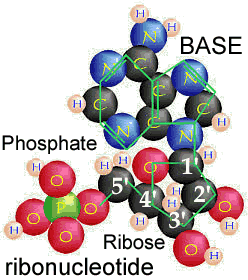 |
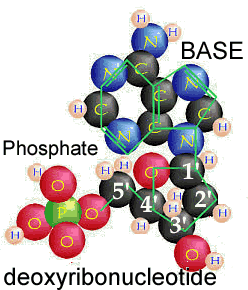 |
|
|
This reaction leaves a triphosphate at 5' end of the "dinucleotide" and a 3' OH group at the other. Nucleic acid polymers are defined by their 5' phosphate ends and 3' OH ends. They have a direction. The reaction can continue; a dinucleotide can react with a nucleotide triphosphate to generate a trinucleotide. In this reaction, the 5' phosphate of the NTP is lost and a phosphodiester bond [-C-O-P-O-C] is formed, but the 3' OH group remains, and can react with another NTP. In this way, nucleotide polymers of unlimited length can be generated. Each such polymer has a 5' phosphate end, a 3' hydroxyl end, phosphodiester linked nucleotides, and a direction. |
|
Nucleotide assembly into polymers is a thermodynamically unfavorable reaction made possible because it is coupled to thermodynamically favorable NTP hydrolysis (ADP formation) reactions. energy + ADP + phosphate ↔ ATP (favorable) nucleotide mono- or diphosphate + phosphate(s) + ATP ↔ nucleic acid (N) + nucleotide triphosphate ↔ nucleic acid (N+1) + diphosphate (unfavorable) |
|
|
|
Discovering the structure of DNA When analyzing DNA, he found that the relative amounts of G, C, T and A in DNA varied between organisms but were the same (or very similar) for organisms of the same type or species. On the other hand, the ratios of A to T and G to C were always equal to 1, no matter where the DNA came from [note: this rule does not apply to RNA.] |
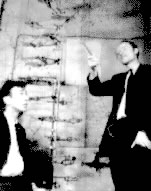 |
Knowing these rules, James Watson and Francis Crick built a model of DNA that fit the molecular and structural data, using structural data from Rosalind Franklin. Their structure was double helical; two nucleotide polymer strands ran anti-parallel to one another and the bases were stacked upon one another in the center. |
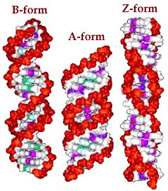 |
|
Their model was for what is now known as B-form DNA. Under different conditions, DNA can form two other double helical forms, known as the A and Z forms. A and B forms of DNA are "right-handed" helices, the Z-form of DNA is a left-handed helix (pictured above). Both purines and pyrimidines are flat in the ring plane. The upper and lower surfaces of the rings are hydrophobic, while the edges are hydrophilic. |
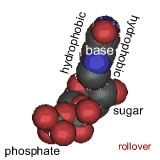 |
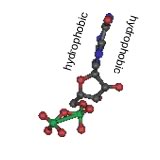 |
 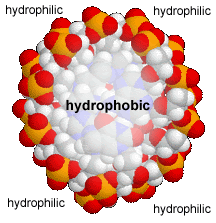 |
This means that the same factors that favor the assembly of lipids into membranes are involved in nucleic acid structure. To reduce their interactions with water, the interactions between hydrophobic surfaces and water need to be minimized. At the same time, each nucleotide has two very hydrophilic groups: a negatively charged phosphate and a sugar (carbohydrate) group. Both form H-bonds and will interact strongly with water. How can the conflicting "molecular desires" of the nucleotides be satisfied? The most obvious [←] way is to stack the hydrophobic surfaces of the bases in the center of the molecule and place the sugars and phosphates at the periphery, in contact with water. |
|
A "bases-inward" organization was key to Watson and Crick's model of DNA structure. At the same time, each base has a hydrophilic edge, with -C=O and -N-H groups that can act as H-bond acceptors and donors. How are these hydrophilic groups arranged in the hydrophobic interior? |
 |
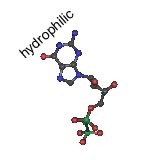 |
|
In all forms of DNA, the hydrophilic edges of the bases interact in a very specific way. An A forms two H-bonds with a T on the opposite strand, while a G forms three H-bonds with a C.
|
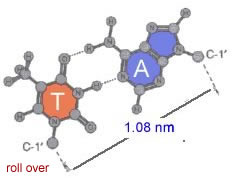 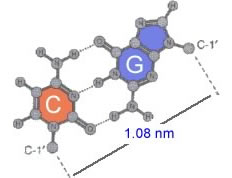 |
|
Any possible sequence can be found, at least theoretically, in a DNA molecule. This means that DNA can be used to encode information in the sequence of nucleotides along its length. Second, the sequence of base pairs along one strand of a DNA molecule is the complement of the base pair sequence on the other. The two strands are informationally redundant; this is of practical importance, for the repair of mutated DNA. If you know the sequence of one strand of a double-stranded DNA molecule, you automatically know the sequence of the other, anti-parallel strand. This has important implications for the replication of hereditary information. |
|
|
RNA structure:   |
Ribonucleic acid or RNA differs from DNA in that RNA contains i) the sugar ribose, rather than dexoyribose, ii) it contains the pyrimidine uracil while DNA contains the pyrimidine thymine, and iii) RNA is typically single rather than double stranded except in some viruses. Being single stranded removes a major constraint on the structural diversity of RNA molecules. |
|
Once thought of as passive transmitters of information from DNA to protein (as messenger or mRNAs), it is now clear that RNAs play many different functional roles within the cell, including transfer (tRNAs), ribosomal (rRNAs), and various types of regulatory molecules (these will be considered in later classes.) These diverse functions are possible because RNAs (unlike double stranded DNAs) can fold into complex three dimensional shapes. As in the case of DNA, entropic effects will act to minimize the interactions between water and the hydrophobic surfaces of the nucleotide bases, and maximize the interactions between water and the hydrophilic phosphates and sugars. This is accomplished by folding the single-stranded RNA molecule back upon itself, and often leads to the formation of double-stranded "stems" that end in single-stranded "loops". Regions within a stem that do not base pair will bulge out. |
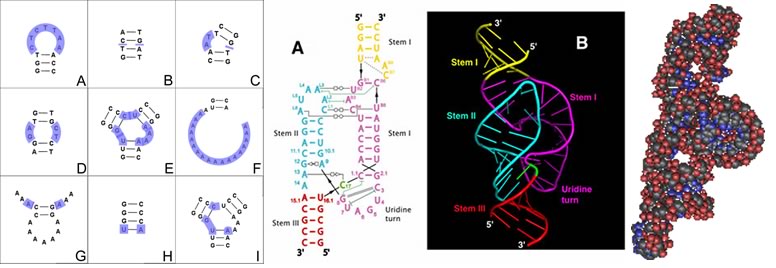
|
Left : various structural motifs found in RNA; Center: flat and ribbon schematics of the structure of an RNA; Right: a van der Waals surface rendering of an RNA molecule.
|
| The ability of RNA to both encode information in its base sequence and to mediate catalysis through its three dimensional structure has led to the RNA world hypothesis. |
|
This states that early organisms relied on RNAs, or more likely simpler RNA-like molecules, rather than DNA and proteins, to both store genetic information and to catalyze reactions. |
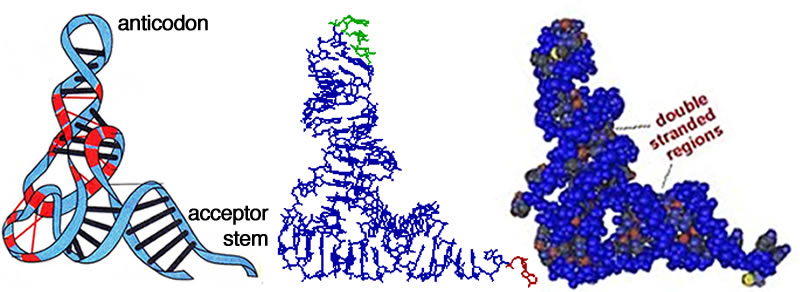 |
|
According to this hypothesis, it was only later in the evolutionary process that organisms develop more specialized DNA-based systems for genetic information storage and proteins for catalysis and other structural functions. There are many unsolved issues associated with a simplistic RNA world view, the most important being the complexity of RNA subunits and their abiogenic synthesis and survival. Nevertheless, it is becoming well established that catalytic RNAs play a key role in modern cells, and early evolution as well. Take the ubiquitous ribosome, which is involved in protein synthesis; its catalytic activity is based on a ribozyme, a RNA-based catalyst. |
|
|
|
Questions to answer |
|
|
Questions to ponder
|
|
|
|
| replace with revised beSocratic activity |
|
|
|
modified
10-May-2014
|